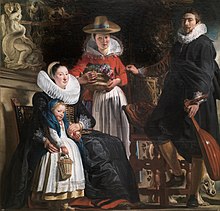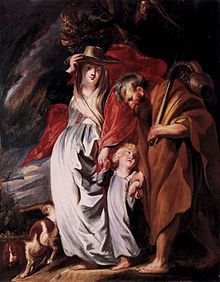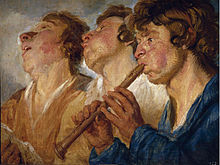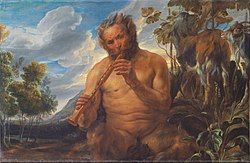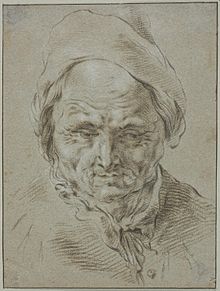Jacob Jordaens
Jacob Jordaens (Antwerp, May 19, 1593 – October 18, 1678) was a Flemish Baroque painter. He is the last great master of the period in the Netherlands, after the death of Rubens (1640) and Van Dyck (1641). Unlike his contemporaries, he never made a formative trip to Italy to learn classical art, and his career is marked by a certain indifference to courtly or intellectual ambitions. He is considered, from his few trips outside the Netherlands, as a painter of considerable genius despite his local character.
He was a successful painter, occasional engraver, and noted tapestry designer. Like Rubens, Jordaens was a master of tapestries, mythological scenes and allegories, and from 1640 -the year Rubens died- he was the most notable painter in Antwerp, and as such he received numerous commissions from courtiers, families wealthy and other patrons. Today, however, his genre painting is better known, works based on costumbrist scenes in the manner of his contemporary Jan Brueghel the Elder. His influences include not only Flemish painters such as Brueghel or the aforementioned Rubens, but also artists from northern Italy such as Jacopo Bassano, Paolo Veronese or Caravaggio.
Biography
Jacob Jordaens was born in Antwerp on May 19, 1593, the eldest among eleven children of wealthy linen merchant Jacob Jordaens and Barbara van Wolschaten. Little is known about his early education, but it is widely accepted that he must have received advanced training as heir to a rich family. This idea is confirmed by his mastery of grammar, his knowledge of French and his competence in mythological matters. His familiarity with Biblical subjects is manifested in his many religious-themed paintings, and his attachment to these issues is confirmed by his late conversion from Catholicism to Protestantism. Like Rubens, he studied under Adam van Noort, who was his only teacher.. During this time Jordaens resided in the Van Noort household and established close ties with the family. After eight years of training with Van Noort, he joined the Guild of Saint Luke as waterscilder or &# 34;watercolourist". At the time, this was a medium that used to be used as a base for tapestries and perhaps this explains why the author's watercolors are not preserved.
In 1616, the same year he was admitted to the brotherhood, Jordaens married his teacher's eldest daughter, Anna Catharina van Noort, with whom he had three children. In 1618 the couple bought a house on the Hoogstraat, the street where he had grown up. Around 1639 he extended it to the adjoining house, just as Rubens had done two decades earlier. He there he resided and worked until his death in 1678.
Jordaens never made the classic learning trip to Italy to study classical and renaissance art. Despite this, he went to great lengths to acquire prints by the great Italian masters that could be found in Northern Europe at the time. This is how he met Titian, Veronese, Caravaggio and Bassano. His work, however, reveals his strong roots as a local painter, and his attachment to the genre painting of artists such as Brueghel the Elder, with a manners nature and a rather humorous tone. Most of his commissions came from wealthy patrons Flemings and members of the clergy, although towards the end of his career the master was already receiving commissions from courtiers and governments throughout Europe. In addition to a considerable number of oil paintings, throughout his career he made numerous tapestries, a trace of his early vocation as a watercolourist.
The importance of Jordaens can be gauged by the number of disciples he had: the register of the Brotherhood of Saint Luke -the traditional guild of painters- points to around fifteen between 1621 and 1667, and to these must be added another six apprentices that are recorded as such in court documents. Among them would be his cousin, and his own son Jacob. Like Rubens and other artists of the day, Jordaens's studio relied heavily on his assistants for the production of his paintings. Although not many of his disciples became famous, holding a position in Jordaens' studio was a position coveted by artists from all over Europe.
Influence of Rubens
Pedro Pablo Rubens was perhaps the painter who most influenced Jordaens' work. The master commissioned some reproductions of his sketches, which perhaps explain his affinity for a warm color palette, his common interest in naturalism, and his similar adaptation of Italian chiaroscuro and tenebrism. Jordaens, who in Rubens's lifetime had only moderate success as a portrait painter, especially shone in the depiction of common characters of everyday life, both in his paintings of pastoral themes, deeply classical in their roots, and in moral scenes similar to the that had been popularized by Jan Steen. Although he was not a specialist, Jordaens used to repeat certain themes throughout his works, with the intention of personalizing characters that appear throughout his work at different ages, forming part of the motley crowd that surrounds the table of a large feast. Regarding mythological themes, Jordaens stuck to the motifs elaborated by Rubens, although filtering them through his tendency to personalization and realistic costumbrismo, as well as a certain burlesque air that permeates even his works with mythological or religious themes. The Prometheus, from c. 1640 is a clear example of the combined influence of Rubens and Frans Snyders.
Themes
In addition to being known as a notable portrait painter, Jordaens made works on religious themes, works of an allegorical and mythological nature, as well as a good number of engravings. Although he was primarily a historical painter, he also worked on Flemish proverbs, such as "the old man sings, the young man chatters", or representations of Flemish festivals (" The King drinks"). Some of his works demonstrate his interest in animal painting: images of horses, cows, poultry, cats, dogs and sheep frequently appear in his work; they were generally life models. Throughout his life he made a large number of sketches from life of animals and people. After Rubens' death in 1640, Jordaens became the most popular painter in Antwerp, and from then on he began to receive commissions from the main courts of Europe, especially from the Nordic kingdoms. The same Rubens heirs requested his help to finish a painting of Hercules freeing Andromeda (Museo del Prado) commissioned by King Philip IV from Spain.
Between 1635 and 1640, Rubens afflicted with gout, Jordaens was granted authorization to use the Flemish master's sketches to continue the decoration of the triumphal entry of Cardinal-Infante Ferdinando, the newly appointed governor of the Spanish possessions in the Netherlands. Although the work was eventually lost, Jordaens was also commissioned to complete the paintings decorating the Queen's chamber in Greenwich, a commission that had also initially been given to Rubens, who turned down the job because of his growing health problems.
Lastly, we should note that Jordaens also played an important role in the decoration of the Torre de la Parada, erected between 1636 and 1641. Two of the works attributed to Jordaens are "Apollo and Pan&# 34; (1637, made according to Rubens' sketches) and "Vertumnus and Pomona" (1638). To this production would later be added a & #34;Fall of the Titans", the "Marriage between Peleus and Thetis" and "Cadmus sowing the dragon's teeth& #34;. In 1661 he was commissioned to make three tondoes of considerable size for the city hall of Amsterdam.
Religion
Professing Protestantism was prohibited in Antwerp, at that time a territory subject to the sovereignty of the King of Spain. However, in the last stage of his life, Jordaens became a Protestant, although he continued to receive -and carry out- commissions from the rich Catholic churches of his region. On the other hand, the writing of some heretical texts published between 1651 and 1658 cost him to pay a fine of £200 15 shillings. In 1877 a memorial containing the tombstones of the painter and his colleagues Simon de Pape (I) and Adriaen van Stalbemt was erected in Putte, on the site where the Protestant church and cemetery stood before its demolition.
Jordaens died in October 1678 of a mysterious disease endemic to Antwerp - called 'zweetziekte' or & # 39; polderkoorts & # 39;, in Dutch-, on the same day that he had taken his unmarried daughter Elizabeth, who remained in his family home. His bodies were buried together under a tombstone in the Protestant cemetery in Putte, a village north of the Belgian border, where the remains of his deceased wife Catharina already rested. A year after his death, Jordaens's son made a generous donation of "twenty-five Flemish pounds to the Camer van den Huysarmen in Antwerp", to which he added "The washing and anointing of the body of Christ,' which was relocated to an orphanage for girls. Apparently this donation was made in correspondence with Jordaens's will, although unfortunately this document does not survive.Even without finding Jordaens's will, his kindness was widely recognized by all who knew him.
Towards the end of his career (1652-1678) the painter's creative and artistic talent began to intensify. From his bright youthful palette she turned to acrid, earthy tones, applying so little paint that the fabric beneath him could be seen. With few exceptions -such as the "Historia de Psyche" that he made for his-his own house, his professional dedication began to relax and in a certain way his paintings seem affected by a certain fatigue.
Works
The Adoration of the Shepherds
The Adoration of the Shepherds (1616 - 1618) depicts the Virgin nursing the infant Jesus while some Flemish-looking shepherds prostrate themselves in adoration. The scene shows five figures that, with the exception of the child, appear cut at waist level, underlining the intimacy of the scene.
Before 1616, Jordaens had been interested in the Mannerist color palette, clear and brilliant. However, with this painting, he begins to use light, and not color, as the primary means of modeling figures in space, making his interest in Caravaggio evident. The main light source in "The Adoration..." it is a candle held by Saint Joseph. The effect may be a possible sign of the influence of painters such as Adam Elsheimer, known for placing the main light source in the center of his compositions. Another possible evidence of Caravaggio's influence can be found in the "realist& #3. 4; that Jordaens applies to the theme: The Virgin and Child are presented in a simple, almost rustic way, far from the idealized archetypes that used to be followed in the representations of this same theme.
Jordaens made at least six other versions of the "Adoration" theme. Generally, the composition includes half a dozen figures grouped and cut in various ways, which focus the observer's attention on the Holy Family. This type of composition was intended to intensify the narrative aspect of the scene and accentuate the individual expression of the characters.
The Satyr and the Peasant
This scene in particular, of which Jordaens made many versions, illustrates a moralizing fable by Aesop. The story begins with the meeting between a man and a satyr. One cold day, while they were talking, the man put his fingers to his mouth and blew. When the satyr asked him about that gesture, the man replied that it was to warm his hands. Later, when they sat down to eat, the man raised the hot plate to his mouth and blew again. When the satyr asked why, he replied that it was to cool the food. The satyr then replied, "I cannot consider you a friend, if you say that the same breath heats and cools". The story is intended to illustrate the duality of human nature, although some critics argue that the author's interest was more in the peasant theme than in the moral of the fable.
The particular moment depicted in the painting is when the satyr declares his distrust of man. The man is still eating, when the devil sits up, raising his hand, preparing to leave the house. Jordaens chose to set the scene inside a farmhouse abundant with animals: a bull, a dog, a cat, and a rooster. They settle on the furniture. Similarly, figures of all ages gather around the table: there is a young man behind the man's chair, an old woman holding a small child, and a young woman peering over the satyr's shoulder.
Characteristic of Jordaens' pictorial style is the way in which the figures are pushed towards the center of the composition, crowding into a small space. Jordaens follows the gloomy techniques of chiaroscuro to define dramatic lighting, which highlights some figures in the scene, such as the baby resting on the old woman's lap. In addition, Jordaens recreates naturalistic effects, such as the dirt on the foot of the peasant seated in the foreground, very characteristic of the Flemish tenebrist style of his time. Jordaens recreated other versions of this theme between 1620 and 1621. In this version, he seems to have positioned the sitter for The Satyr and the Peasant in the same way that she appeared in The Adoration of the shepherds, and judging by the large number of copies that have been found - all of them without the master's seal - it is believed that Jordaens had used this painting as a practice exercise for his assistants and students in the workshop.
Works by Jordaens in Spanish collections
In Spain there is an interesting set of his works. The Prado Museum preserves eleven works by his brush, eight of which are mythological, two customs and one religious, as well as a drawing and a gouache. The Thyssen-Bornemisza Museum has a Holy Family with a angel, with the participation of his workshop. Two Embracing Angelsharks. The Bilbao Fine Arts Museum keeps a fragment of Jupiter's Childhood entitled: Satyr playing the flute, and a Peasant head
Rapestries
Tapestry designs represent a very significant part of his work. Rich tapestries, which were among the most lucrative works made between the Renaissance and the Baroque, covered the halls of the luxurious mansions of the European aristocracy since the XIV. Artists such as Jacob Jordaens, Pedro Pablo Rubens or Pietro da Cortona used to make them to order, representing their wealthy patrons in mythological or historical scenes charged with symbolism and propaganda significance. Jordaens became a specialist in this type of works, and his dedication and skill won him a good number of clients. He was considered one of the greatest tapestry designers of his day.
The process of creating tapestries began with a preliminary sketch of the work. The drawing was transferred to a larger format, painted in oil on cardboard, which was delivered to the mill where it was transformed into a piece of cloth. Jordaens also used to make small watercolor sketches of his compositions, although towards the end of his career he replaced cardboard with the same canvas as the final format. His tapestries were designed to be transported by their wealthy owners, who often took them on their travels or military campaigns as a symbol of his status. The field of topics to be dealt with was very wide, ranging from mythology or rural life to the history of Charlemagne. Some experts emphasize that a characteristic feature of Jordaens' production in this area it was the composition with masses of characters, flattened by the two-dimensional format of the canvas, which strongly emphasized the texture patterns. Somehow, Jordaens transferred to tapestries his taste for including a multitude of characters in his works, whether they were tapestries or paintings.
The sketch for "interior of a kitchen", which we present here, is an example of a typical state of work in the work of Jordaens. Using ocher ink, he applied the color over a blot of black chalk, sketching on the paper the final composition of the still life on the table and the arrangement of the figures. The final result differed slightly, but as some authors have pointed out, the work was inspired, in its initial stages, by the still lifes of the Antwerp artist Frans Snyders, who was very close to Jordaens' interests.
Drawings
Some critics have noted that Jordaens's work continued stylistically the "pictorialism" characteristic of the drawings of Rubens or Van Dyck in their own sketches. Currently, there are around 450 drawings attributed to the master, although the similarity of his techniques causes some disagreement among experts when it comes to distinguishing his work from that of Rubens. In any case, Jordaens and his contemporaries were the main exponents of the Flemish trend towards making preparatory sketches and notes on a smaller scale than the final image. Jordaens was an accomplished draftsman who did not hesitate to use pictorial techniques -such as gouache or watercolor- in the execution of his sketches. His work on paper is also characterized by its economy of means, and it was not uncommon for him to add strips of paper, cut out sections of the format or paste isolated fragments (in the manner of a collage) on the paper, until achieve the desired effect.
A Concrete Study: The "Allegory of April"
The subject matter of this drawing (date unknown) has been the subject of some controversy. This portrait of a nude woman on the back of a bull would most likely be a representation of the well-known mythological theme of "the kidnapping of Europa", which presents Jupiter metamorphosed into a bull. However, some theories interpret it as an allegory for the month of April: according to that reading, the bull would represent the zodiac sign of Taurus, while the woman, holding a bouquet of flowers, would be identified with Flora, the goddess of Spring.. The figures that escort her would therefore be Ceres, the god of agriculture, and Silenus, instructor and adviser to Bacchus.
Engravings
Jordaens' facet as an engraver is not known among the uninitiated public and rarely deserves attention in art monographs, except for specific books on antique engraving. The expert Hollstein assigned Jordaens seven engraved images, several of them with the date 1652; Authorship seconded in modern times (1993) by the expert D'Hulst.
The seven engravings bear the name of Jordaens inscribed as «inventor» (designer of the image), which suggests that the work of engraving the matrices was done by another hand; but the general conviction is that he did all the work. They are etched with a decent result in terms of drawing, although they lack the skill and expressiveness of the most celebrated etchers such as Rembrandt and José de Ribera.
Their subjects are varied and Jordaens had already captured almost all of them in paintings: Christ expelling the merchants from the temple, Lamentation before the dead Christ, Juno surprising Jupiter and Io, Mercury killing Argos, Jupiter fed by the goat Amalthea, The flight into Egypt and a rural theme, Farmer holding a cow by the tail (formerly identified as Cacus stealing Geryon's herd). Copies of these engravings are kept in museums around the world: the British Museum in London, the National Gallery in Washington, the Art Institute in Chicago...
Contenido relacionado
196
Moment
France
